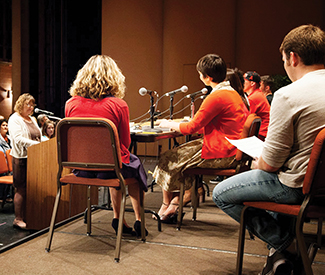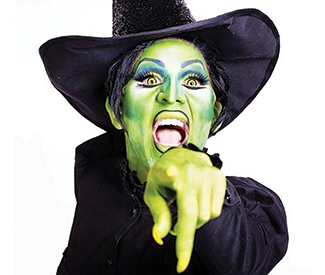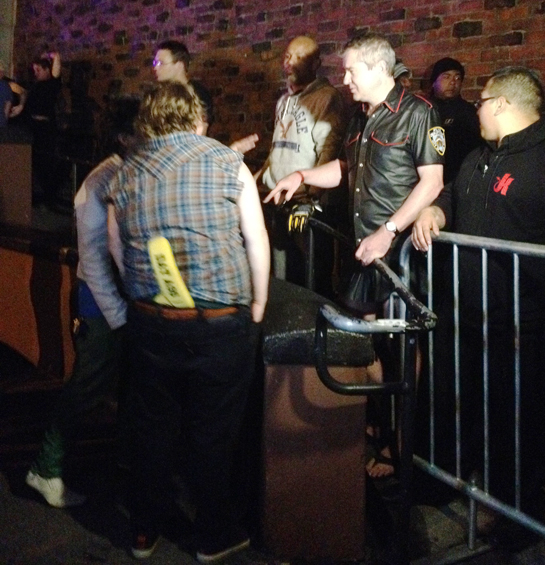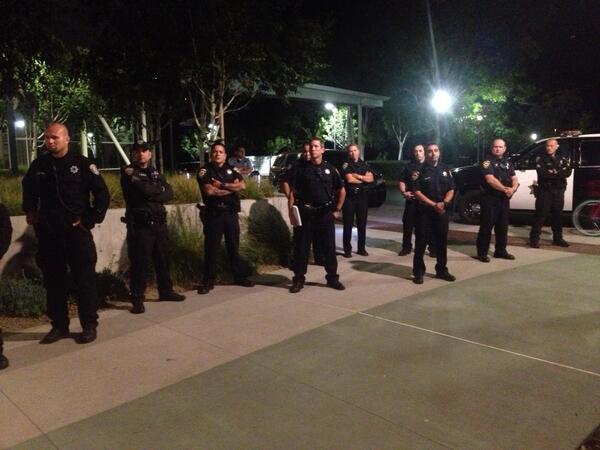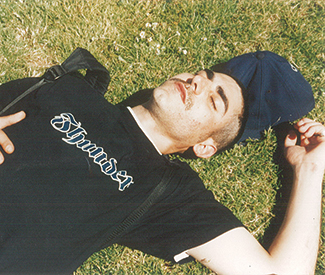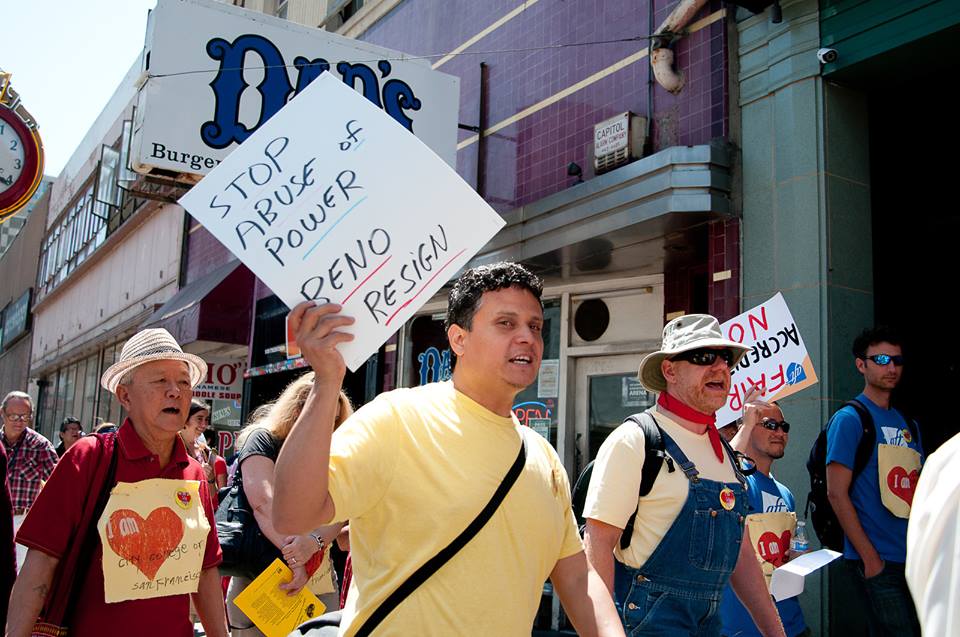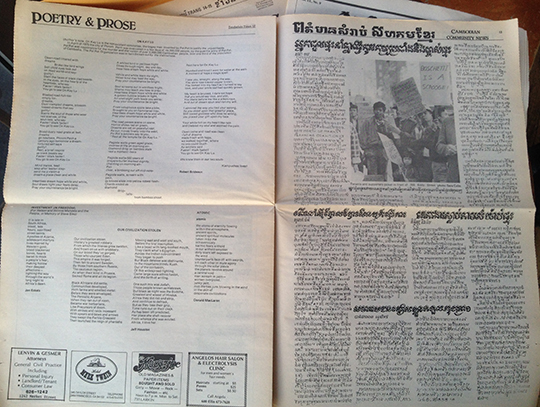Stage listings are compiled by Guardian staff. Performance times may change; call venues to confirm. Reviewers are Robert Avila, Rita Felciano, and Nicole Gluckstern. Submit items for the listings at listings@sfbg.com.
THEATER
OPENING
36 Stories by Sam Shepard Z Below, 470 Florida, SF; www.36stories.org. $35-55. Previews Wed/21-Thu/22, 7pm; Fri/23, 8pm. Opens Sat/24, 8pm and Sun/25, 7pm. Runs Wed-Thu, 7pm; Fri-Sat, 8pm; Sun, 3pm. Through June 22. Word for Word performs director Amy Kossow’s original adaptation of Shepard’s poetry and fiction.
BAY AREA
Daylighting: The Berkeley Stories Project Ashby Stage, 1901 Ashby, Berk; www.shotgunplayers.org. $20-35. Previews Wed/21-Sat/24, 8pm; Sun/25, 5pm; May 28-29, 7pm. Opens May 30, 8pm. Runs Wed-Thu, 7pm; Fri-Sat, 8pm; Sun, 5pm (June 22, show at 2pm). Through June 22. Shotgun Players present Dan Wolf’s new play inspired by real-life tales from Berkeley residents past and present.
“Fringe of Marin” Angelico Concert Hall, Dominican University, 20 Olive, San Rafael; www.fringeofmarin.com. $10-20. Schedule varies; runs May 23-June 1. Fringe of Marin celebrates its 33rd season with 11 original one-act plays presented in two programs.
ONGOING
“Best of PlayGround 18” Thick House, 1695 18th St, SF; www.playground-sf.org. $22-55 (all-fest pass, $60-75). Thu/22-Sat/24, 8pm; Sun/25, 7pm. Short plays and musicals by Bay Area writers.
Chasing Mehserle Intersection for the Arts, 925 Mission, SF; chasingmehserle.brownpapertickets.com. $25. Thu/22-Sat/24, 8pm. Also May 29-31, 8pm, $15-25, Z Space, 450 Florida, SF; www.zspace.org. Intersection for the Arts, Campo Santo, and the Living Word Project present Chinaka Hodge’s performance piece about Oakland in the aftermath of the Oscar Grant killing.
Communiqué N°10 Exit on Taylor, 277 Taylor, SF; www.cuttingball.com. $10-50. Thu/22, 7:30; Fri/23-Sat/24, 8pm (also Sat/24, 2pm); Sun/25, 5pm. Amid a fractious band of young rebels from the urban underclass and ongoing rioting in the streets, a young immigrant named Hassan (Damien Seperi) searches for the man who killed his 16-year-old brother. French playwright Samuel Gallet’s Communiqué N°10 draws immediate inspiration from the Paris riots of 2005, but the tinderbox of extreme inequality and anti-immigrant policies are hardly a French monopoly (indeed, the standoff last year between immigrant rights demonstrators and French police following the deportation of a Roma student, snatched off a school bus in front of her classmates, sounds all too familiar to Americans living through Obama’s unprecedented wave of deportations and incarcerations of undocumented people and the popular protest rising against it). Cutting Ball Theater’s US premiere of Gallet’s play, however, strains after its subject, timely though it is. Presented in association with Golden Thread Productions as part of the second biennial Des Voix&ldots; festival of new French plays and cinema, director and translator Rob Melrose’s production sets the action on a spare set (designed by Michael Locher) ringed by a two-tier framework of metal piping, about which some of the seven-member cast climb and roost. But the sparse setting is in fact overwhelmed with altogether too much stage business, including Emma Jaster’s somewhat labored choreography and Cliff Caruthers’ often distracting soundscape, which only detracts from the already difficult-to-follow plot points and further undermines an ensemble that never really coheres. Add to this contrived dialogue such as Hassan’s retort to having his picture snapped by love-interest Marlene (Maura Halloran) — “Images. We never know what purposes they serve in the end” — and what should be a tense and dynamic drama instead becomes a dreary, vaguely didactic ball of confusion. (Avila)
“DIVAfest” Exit Theatre, 156 Eddy, SF; www.divafest.info. Prices and showtimes vary. Through Sat/24. This 13th annual festival celebrates the work of women artists, with performances including the premiere of Rat Girl (adapted from the memoir by rocker Kristin Hersh), Margery Fairchild’s ballet comedy The Pas De Quatre, a reading by acclaimed poet Diane di Prima, and more.
Dracula Shelton Theater, 533 Sutter, SF; sfdracula.blogspot.com. $35. Thu-Sat, 8pm. Through May 31. Kellerson Productions presents a new adaptation of the Bram Stoker classic.
Feisty Old Jew Marsh San Francisco Main Stage, 1062 Valencia, SF; www.themarsh.org. $25-100. Sat-Sun, 5pm. Extended through July 13. Charlie Varon performs his latest solo show, a fictional comedy about “a 20th century man living in a 21st century city.”
Foodies! The Musical Shelton Theater, 533 Sutter, SF; www.foodiesthemusical.com. $32-34. Fri-Sat, 8pm. Open-ended. AWAT Productions presents Morris Bobrow’s musical comedy revue all about food.
The Homosexuals New Conservatory Theatre Center, Decker Theatre, 25 Van Ness, SF; www.nctcsf.org. $25-45. Previews Wed/21 and Fri/23, 8pm. Opens Sat/24, 8pm. Runs Wed-Sat, 8pm; Sun, 2pm. Through June 28. New Conservatory Theatre Center performs Philip Dawkins’ play about a young man struggling with his identity amid a new group of friends.
Lovebirds Marsh San Francisco Studio, 1062 Valencia, SF; www.themarsh.org. $20-100. Fri, 8pm; Sat, 8:30pm. Through May 31. Award-winning solo theater artist Marga Gomez brings her hit comedy back for a limited run before taking it to New York in June.
Pearls Over Shanghai Hypnodrome Theatre, 575 10th St, SF; www.thrillpeddlers.com. $30-35. Thu-Sat, 8pm. Extended through June 28. Five years ago, Thrillpeddlers breathed new life into a glitter-dusted piece of Sixties flotsam, beautifully reimagining the Cockettes’ raunchy mock-operetta Pearls Over Shanghai (in collaboration with several surviving members of San Francisco’s storied acid-drag troupe) and running it for a whopping 22 months. Written by Cockette Link Martin as a carefree interpretation of a 1926 Broadway play, the baldly stereotyped Shanghai Gesture, it was the perfectly lurid vehicle for irreverence in all directions. It’s back in this revival, once again helmed by artistic director Russell Blackwood with musical direction by Cockette and local favorite Scrumbly Koldewyn. But despite the frisson of featuring some original-original cast members — including “Sweet Pam” Tent (who with Koldewyn also contributes some new dialogue) and Rumi Missabu (regally reprising the role of Madam Gin Sling) — there’s less fire the second time around as the production straddles the line between carefully slick and appropriately sloppy. Nevertheless, there are some fine musical numbers and moments throughout. Among these, Zelda Koznofsky, Birdie-Bob Watt, and Jesse Cortez consistently hit high notes as the singing Andrews Sisters-like trio of Americans thrown into white slavery; Bonni Suval’s Lottie Wu is a fierce vixen; and Noah Haydon (as the sultry Petrushka) is a class act. Koldewyn’s musical direction and piano accompaniment, meanwhile, provide strong and sure momentum as well as exquisite atmosphere. (Avila)
Romeo and Juliet Phoenix Theatre, 414 Mason, Ste 601, SF; www.eventbrite.com. $20. Thu/22-Sat/24, 8pm (also Sat/24, 3pm). Ninjaz of Drama performs Shakespeare’s tragic romance.
Seminar San Francisco Playhouse, 450 Post, Second Flr, SF; www.sfplayhouse.org. $20-100. Tue-Thu, 7pm; Fri-Sat, 8pm (also Sat, 3pm); June 1 and 8, 2pm. Through June 14. San Francisco Playhouse performs Theresa Rebeck’s biting comedy.
Shit & Champagne Rebel, 1772 Market, SF; shitandchampagne.eventbrite.com. $25. Fri-Sat, 8pm. Open-ended. D’Arcy Drollinger is Champagne White, bodacious blond innocent with a wicked left hook in this cross-dressing ’70s-style white-sploitation flick, played out live on Rebel’s intimate but action-packed barroom stage. Written by Drollinger and co-directed with Laurie Bushman (with high-flying choreography by John Paolillo, Drollinger, and Matthew Martin), this high-octane camp send-up of a favored formula comes dependably stocked with stock characters and delightfully protracted by a convoluted plot (involving, among other things, a certain street drug that’s triggered an epidemic of poopy pants) — all of it played to the hilt by an excellent cast that includes Martin as Dixie Stampede, an evil corporate dominatrix at the head of some sinister front for world domination called Mal*Wart; Alex Brown as Detective Jack Hammer, rough-hewn cop on the case and ambivalent love interest; Rotimi Agbabiaka as Sergio, gay Puerto Rican impresario and confidante; Steven Lemay as Brandy, high-end calf model and Champagne’s (much) beloved roommate; and Nancy French as Rod, Champagne’s doomed fiancé. Sprawling often literally across two buxom acts, the show maintains admirable consistency: The energy never flags and the brow stays decidedly low. (Avila)
Sleeping Cutie: A Fractured Fairy Tale Musical Thick House, 1695 18th St, SF; sleepingcutiemusical.tix.com. $30-40. Wed/21, 8pm. Off a Cliff Productions and PlayGround present Diane Sampson and Doug Katsaros’ world-premiere musical.
The Speakeasy Undisclosed location (ticket buyers receive a text with directions), SF; www.thespeakeasysf.com. $65-100 (gambling chips, $7-10 extra; after-hours admission, $10). New schedule: Wed-Sat, 7:30, 7:40, 7:50, 8pm, and 9pm admittance times. Extended through June 21. Boxcar Theater’s most ambitious project to date is also one of the more involved and impressively orchestrated theatrical experiences on any Bay Area stage just now. An immersive time-tripping environmental work, The Speakeasy takes place in an “undisclosed location” (in fact, a wonderfully redesigned version of the company’s Hyde Street theater complex) amid a period-specific cocktail lounge, cabaret, and gambling den inhabited by dozens of Prohibition-era characters and scenarios that unfold around an audience ultimately invited to wander around at will. At one level, this is an invitation to pure dress-up social entertainment. But there are artistic aims here too. Intentionally designed (by co-director and creator Nick A. Olivero with co-director Peter Ruocco) as a fractured super-narrative — in which audiences perceive snatches of overheard stories rather than complete arcs, and can follow those of their own choosing — there’s a way the piece becomes specifically and ever more subtly about time itself. This is most pointedly demonstrated in the opening vignettes in the cocktail lounge, where even the ticking of Joe’s Clock Shop (the “cover” storefront for the illicit 1920s den inside) can be heard underscoring conversations (deeply ironic in historical hindsight) about war, loss, and regained hope for the future. For a San Francisco currently gripped by a kind of historical double-recurrence of the roaring Twenties and dire Thirties at once, The Speakeasy is not a bad place to sit and ponder the simulacra of our elusive moment. (Avila)
“Des Voix: Found in Translation Biennial 2014” Various venues, SF; www.desvoixfestival.com. Prices vary. Through Sun/25. In addition to Communiqué N°10 (listed above), this festival of contemporary French playwrights and cinema includes four new play translations, a “New Play Nightclub,” film screenings, and more. Presented by Playwrights Foundation, Tides Theatre, Cutting Ball Theater, French International School, and the French Consulate of San Francisco.
The World’s Funniest Bubble Show Marsh San Francisco, 1062 Valencia, SF; www.themarsh.org. $8-11. Sun/25, 11am. The popular, kid-friendly show by Louis Pearl (aka “The Amazing Bubble Man”) returns to the Marsh.
BAY AREA
The Color Purple Hillbarn Theatre, 1285 East Hillsdale, Foster City; www.hillbarntheatre.org. $23-38. Thu-Sat, 8pm; Sun, 2pm. Through June 1. Hillbarn Theatre closes its 73rd season with the musical adaptation of Alice Walker’s classic novel.
The Crazed Berkeley City Club, 2315 Durant, Berk; www.centralworks.org. $15-28. Thu-Sat, 8pm; Sun, 5pm. Through June 23. Central Works performs Sally Dawidoff’s play, based on Ha Jin’s novel about coming of age in Communist China.
Geezer Marsh Berkeley, 2120 Allston, Berk; www.themarsh.org. $25-50. Wed/21, 8pm; Sat/24, 3pm. Geoff Hoyle moves his hit comedy about aging to the East Bay.
The Intelligent Homosexual’s Guide to Capitalism and Socialism with a Key to the Scriptures Berkeley Repertory Theatre, Roda Theatre, 2015 Addison, Berk; www.berkeleyrep.org. $14.50-89. Opens Wed/21, 7:30pm. Runs Tue, Thu-Sat, 7:30pm (also May 29, June 26, and all Saturdays in June, 2pm); Wed and Sun, 7pm (also Sun, 2pm). Through June 29. Berkeley Rep performs the West Coast premiere of Tony Kushner’s latest play.
The Letters Harry’s UpStage, Aurora Theatre Company, 2081 Addison, Berk; www.auroratheatre.org. $28-32. Wed-Sat, 8pm; Sun, 2pm. Through June 1. American playwright John W. Lowell’s The Letters harkens back to Stalinist days and some unspecified ministry, where a dutiful staff goes about censoring the personal and openly homoerotic correspondence of an iconic Russian composer (Tchaikovsky). Directed by Mark Jackson for Aurora Theater’s new upstairs black box, the two-hander unfolds in the small but tidy and dignified office belonging to the ministry’s director (an imposing Michael Ray Wisely). He has summoned one of his employees, a widow named Anna (a taut Beth Wilmurt), for reasons not immediately clear to her or us. A careful dance around a minefield of protocol, sexual innuendo, and hidden agendas ensues, as a dangerous and deadly scandal surrounding the aforementioned letters makes itself felt. Given the Ukraine crisis, the ramping up of Cold War II, and Russia’s increasing authoritarianism — including its new law against homosexual “propagandizing” in the cultural realm, and a Ministry of Culture vowing to withhold funding from art lacking in “spiritual or moral content” — it’s all a remarkably timely little time warp. And Lowell’s story is cleverly crafted for the most part. Unfortunately, the production’s two capable actors have a hard time conveying a lifelike (if however strained) relationship or the perspiration-inducing tension the drama purports to carry. At the same time, the drama’s dialogue, at least as played here, can stretch the bounds of verisimilitude by veering from flinty, cagey ducks and jabs to outright insubordination, sarcasm, and ineffectual blustering — the latter outbursts seeming to leave the pressure pot of the Great Terror far behind. It’s still a long way from Tom and Jerry, but as a cat and mouse game the stakes, and the arc of the story, feel more fantastical then pressingly contemporary. (Avila)
Mutt: Let’s All Talk About Race La Val’s Subterranean, 1834 Euclid, Berk; www.impacttheatre.com. $10-20. Thu-Sat, 8pm; Sun, 7pm. Through June 8. Impact Theatre and Ferocious Lotus Theatre Company present the world premiere of Christopher Chen’s political satire.
Nantucket Marsh Berkeley MainStage, 2120 Allston, Berk; www.themarsh.org. $25-100 (all tickets include a picnic dinner). Thu and Sat, 7pm. Through June 14. Acclaimed solo performer Mark Kenward presents his “haunting yet hilarious” autobiographical show about growing up on Nantucket.
Not a Genuine Black Man Osher Studio, 2055 Center, Berk; www.berkeleyrep.org. $30-45. Thu-Sat, 8pm. Through May 31. Brian Copeland brings his acclaimed, long-running solo show to Berkeley Rep for a 10th anniversary limited run.
Other Desert Cities Barn Theatre, 30 Sir Francis Drake, Ross; www.rossvalleyplayers.com. $10-26. Thu, 7:30pm; Fri-Sat, 8pm; Sun, 2pm. Through June 15. Ross Valley Players perform Jon Robin Baitz’s Pultizer-nominated drama about a tense family holiday.
“Pear Slices” Pear Avenue Theatre, 1220 Pear, Mtn View; www.thepear.org. $10-35. Thu/22-Sat/24, 8pm; Sun/25, 2pm. Original short plays from the Pear Playwrights Guild.
South Pacific Cushing Memorial Amphitheater, 801 Panoramic Hwy, Mill Valley; www.mountainplay.org. $20-60. Sun and June 7, 2pm (arrive one hour prior to showtime). Through June 15. Mountain Play Association performs the classic Rodgers and Hammerstein musical.
The 25th Annual Putnam County Spelling Bee Lesher Center for the Arts, 1601 Civic, Walnut Creek; www.centerrep.org. $37-65. Wed, 7:30pm; Thu-Sat, 8pm (also June 7, 14, 21, 2:30pm); Sun, 2:30pm. Through June 21. Center REP performs the Tony-winning musical by William Finn and Rachel Sheinkin.
PERFORMANCE/DANCE
Alonzo King LINES Ballet Yerba Buena Center for the Arts Theater, 700 Howard, SF; www.linesballet.org. Wed/21, 9pm (gala, 5:30pm; afterparty, 10pm); Thu/22, 7:30pm; Fri/23-Sat/24, 8pm (also Sat/24, 2pm); Sun/25, 5pm. $20-65. The company’s spring season includes a world premiere and a retrospective of three celebrated works.
“The Amazing Acro-Cats” Fort Mason Center, Southside Theater, Marina at Laguna, SF; www.circuscats.com. Thu/22-Sat/24 and May 29-31, 8:30pm; Sun/25 and June 1, 2 and 5pm. $24. Samantha Martin and her performing cat troupe, including “the only cat band in existence” (with a chicken on tambourine), take the stage. As its press release insists, “Yes, this is real!”
“Arab Love Arab Freedom” Stage Werx, 446 Valencia, SF; www.lisalive.net. Thu/22, 7:30pm. $10-25. Lisa Kotecki performs her solo show as part of the United States of Asian American Festival 2014.
BATS Improv Bayfront Theater, B350 Fort Mason Center, SF; www.improv.org. $20. “Director’s Cut,” Fri/23, 8pm; “The Good, The Bad, and the Improvised,” Sat/24, 8pm.
BrickaBrack Dance Mission Theater, 3316 24th St, SF; www.dancemission.com. Fri/23-Sat/24, 8pm; Sun/25, 7pm. $25-45. The dance-theater company performs never fall so heavily again.
Caroline Lugo and Carolé Acuña’s Ballet Flamenco Peña Pachamama, 1630 Powell, SF; www.carolinalugo.com. Sun/25, June 17, 22, and 29, 6:15pm. $15-19. Flamenco performance by the mother-daughter dance company, featuring live musicians.
“Dash: Improv in a Flash” Un-Scripted Theater Company, 533 Sutter, Second Flr, SF; www.un-scripted.com. Sat, 10pm. $15. Ongoing through Aug 30. A late-night, free-form improv show with Un-Scripted Theater Company.
“Drag Comedy Night” Pa’ina Lounge, 1865 Post, SF; facebook.com/funnynative. Sun/25, 7pm. $10. Hella Gay Comedy presents Victor Ocho, Chile Con Consuela, Lady Camilla Borles, and more, with host Miles Long.
“Lady Bunny in Clowns Syndrome” Rebel, 1760 Market, SF; ladybunny.eventbrite.com. Sat/24, 8 and 10pm; Sun/25, 7 and 9pm. $25. Drag superstar Lady Bunny performs an all-new musical show.
“Magic at the Rex” Hotel Rex, 562 Sutter, SF; www.magicattherex.com. Sat, 8pm. Ongoing. $25. Magic and mystery with Adam Sachs and mentalist Sebastian Boswell III.
“Out of Line Improv” Stage Werx, 446 Valencia, SF; outoflineimprov.brownpapertickets.com. Sat, 10:30pm. $12. Ongoing. A new, completely improvised show every week.
“San Francisco Comedy College” Purple Onion at Kells, 530 Jackson, SF; www.purpleonionatkells.com. $5-10. “New Talent Show,” Wed-Thu, 7. Ongoing. “The Cellar Dwellers,” stand-up comedy, Wed-Thu, 8:15pm and Fri-Sat, 7:30pm. Ongoing.
“17th Annual Dionysian Festival” Mary Sano School of Duncan Dancing, 245 Fifth St, Studio 314, SF; www.duncandance.org. Sat/24, 8pm; Sun/25, 5pm. $20. Performance with live music celebrating the 137th anniversary of modern dance pioneer Isadora Duncan’s birth.
“Threepenny Opera” Phoenix Annex Theater, 414 Mason, Ste 406, SF; www.waffleopera.com. Sun/25 and June 1, 2pm; May 31, 7:30pm. $15-25. Waffle Opera performs the Weill and Brecht classic.
“Tro Ve Nuoc” Mission Cultural Center, 2868 Mission, SF; www.trovenuoc.bpt.me. Fri/23, 6 and 8pm. $7-20. A performance about two Vietnamese American women in search of home in the Diaspora, presented as part of the United States of Asian American Festival 2014.
“Yerba Buena Gardens Festival” Yerba Buena Gardens, 760 Howard, SF; www.ybgfestival.org. Free. Through Oct 26. This week: SFSU Afro-Cuban Jazz Ensemble, Wed/21, 6-8pm; Babá Ken Okulolo and Kotoja, Sun/25, 1-2:30pm; “Poetic Tuesday,” Tue/27, 12:30-1:30pm.
BAY AREA
“Bare Bones” Western Sky Studio, 2525 Eighth St, Berk; www.paufvedance.org. Sat/24, 7:30pm. $20. Randee Paufve and Paufve Dance present this low-tech performance series, featuring works by ahdanco, Angela Demmel and Dancers, Blind Tiger Society, and others.
“Café Flamenco: Dancers of La Traviata” Rhythmix Cultural Works, 2513 Blanding, Alameda; www.rhythmix.org. Sun/25, 7pm. $10-20. Dynamic flamenco choreographed by Yaelisa for the SF Opera’s upcoming performance of La Traviata.
Tommy Davidson Tommy T’s, 5104 Hopyard, Pleasanton; www.tommyts.com. Thu/22-Fri/23, 7:30pm (also Fri/23, 10:15pm); Sat/24, 7 and 9:45pm. $35. The comedian performs.
“MarshJam Improv Comedy Show” Marsh Berkeley, 2120 Allston, Berk; www.themarsh.org. Fri, 8pm. Ongoing. $10. Improv comedy with local legends and drop-in guests. *




